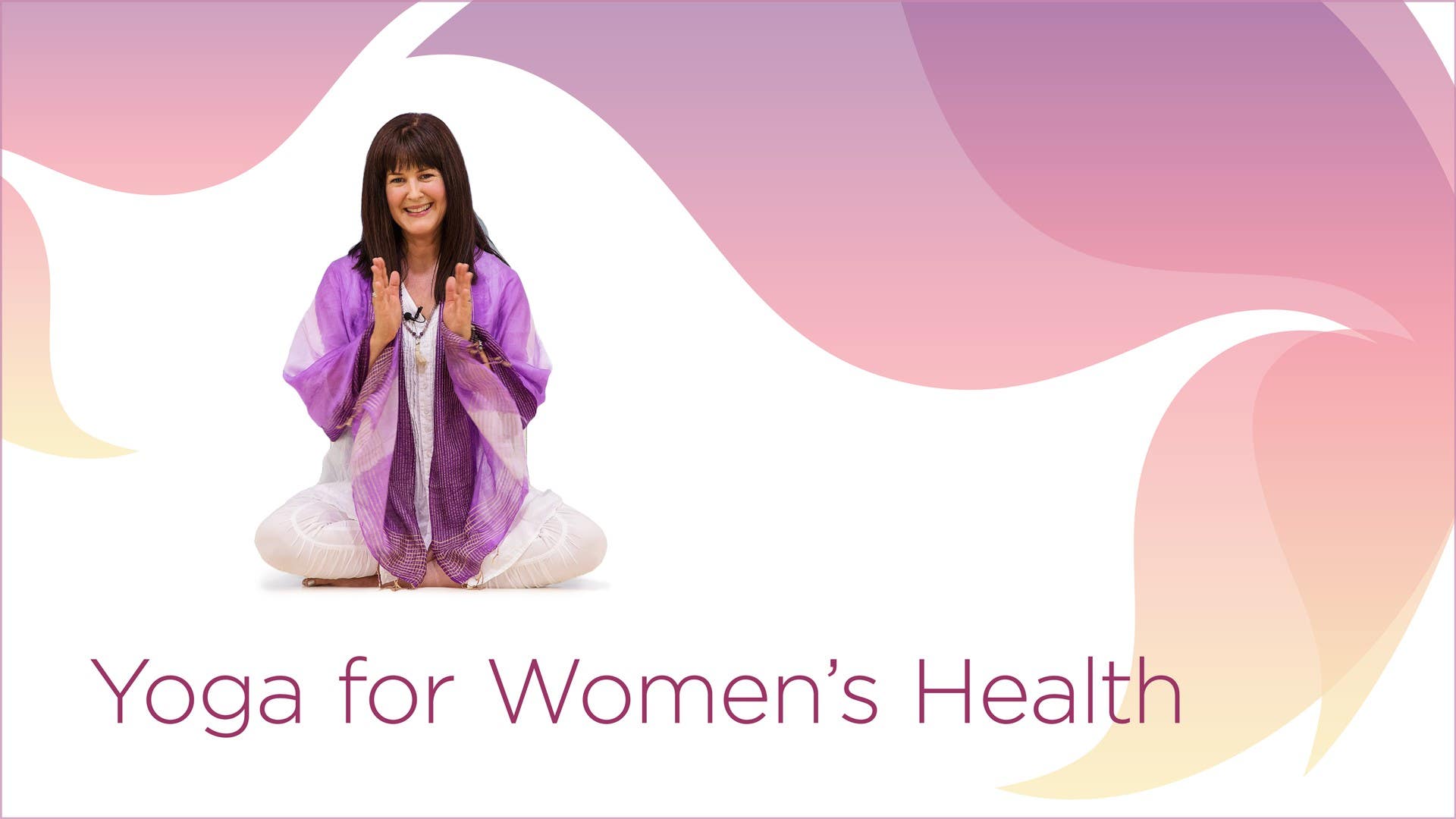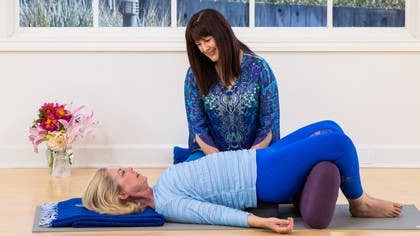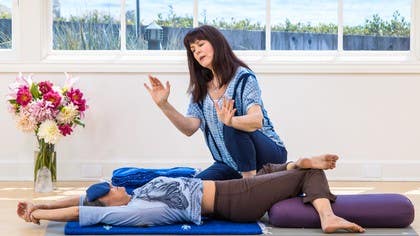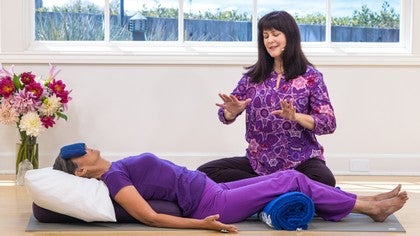Description
About This Video
Transcript
Read Full Transcript
(waves crashing) Thanks for being here as we explore practices for pelvic health and healing. Today, Elizabeth's with me, and she's gonna be demonstrating the poses for you. Some really interesting poses to open the pelvic floor muscles, but also to strengthen them, and to visit this area of our body, the sacred area of our body with our breath and our awareness. If you've experienced trauma, or there's tenderness, or holding in the lower part of the body, meet it with your breath, and with that kind of compassion and kindness that will help you to heal. So we'll start with a squat.
Squats are so great for opening the pelvic floor, and the gentlest variation is where you just bring your feet out while you're sitting on the bolster about hip-width or slightly wider. You can open the feet slightly so there's a little bit of external rotation there, and then the elbows go to the inside of the knees, and the hands come into prayer position. So you take a moment to lengthen up through the spine, and as you come forward, pressing the thumb into the brow as it meets the nose, the calm the spirit point. For those of you that have greater flexibility and you wanna go a little deeper, you can come into a full squat. So coming into a position with your feet a little wider than hip-width, your hands in prayer position, your heels down, or you can always put a roll underneath your heels for a gentler variation.
And once you come here, you can rock a little bit if you like, forward and backward. And feeling the openness in the pelvic floor, and just allowing those muscles to soften. And then when you're done, you can sit back on your bolster. Take a moment to lengthen your spine. And then bringing your hands to the legs, extending the legs out in front of you, and take a moment to point and flex the toes.
And stretching the ankles, the Achilles. And very nice to do, too, before the squat, to just loosen up the heels, the Achilles, and the calves. And then release. So you'll take your props and hopefully you have three blankets and a block and an eye pillow, and I recommend for this next part of the practice to put your block near to you where you can easily reach it and your eye pillow also. And you'll take your yoga bolster, bring that to your yoga mat, and you can take a blanket rolled on top for the first part of our practice of opening up the back and just connecting with the body.
And then you can stretch your legs over that. You can bring a blanket back behind you for your head, and then slowly recline back when you're ready. So we're gonna take a few moments here, connecting with the breath, and exploring the inner body. Feel free to adjust the blanket under your head. Make sure it feels just right.
And sometimes it's nice to just have it flat. Create a little bit of stretch at the occiput, or if you like a roll, you can make a roll or fold it in half, especially if the head's tilting back. You do want your forehead higher than your Adam's apple here. Then you're welcome to take your eye pillow and place it over your eyes. And take a few moments to bring your awareness inside your body.
I always like to start my practice with a body scan so that I can feel what's happening in this moment, and then that can inform you throughout your practice. So as you close your eyes, and as you move inside, notice how you feel. And notice the quality of your breath. How's your breath flowing? Is it deep? Is it short?
And inviting it to lengthen and deepen. And for relaxing the nervous system, it can be good to take a long inhalation, but focus on an even longer exhalation. It's been connected to the vagus nerve and helping to turn off the stress response. One of the quickest ways to give your body the message that you're safe and to help you relax. Taking a few deep breaths.
Long exhalations. Good. And then on your next exhalation, you'll draw your knees towards your chest, and as you hold your knees with your hands, you can rock a little bit from side to side. Massaging across the low back, warming things up a bit here. And then as you come back to center, you can put your feet on the blanket roll that's on top of your bolster, and take your blanket, and you'll just make a nice roll with it.
So you can have it folded in half, and then roll a nice, thick roll, and place it right between your thighs, and you can squeeze that blanket with your knees. Now, depending on how you're feeling today, if you want a gentler variation, you'll keep squeezing the blanket, and you'll bring your hands to the tops of your knees, and you'll hold the knees and draw them towards your chest, and while you squeeze that blanket, you'll start to draw a circle on the ceiling. If you don't have a blanket handy, you could use your block, something that helps you to engage your adductor muscles. In a moment, we're gonna be opening that area, so this helps to warm those muscles and prepare them for a deeper stretch. Now, if you don't have any problems with your low back or your hips, and you'd like to go into a deeper variation, you can put your arms out to the side.
This is gonna strengthen your legs and your abdominal muscles a bit more. And drawing a circle, as if you're circling on the ceiling with your knees squeezing the blanket firmly. Good. Activating the core muscles. As the legs squeeze together, bring them high towards the chest.
That's gonna get a little more activation of the core muscles. Good. And squeezing the blanket, coming back to center, and now going the other direction. Remember, you can always keep your hands on your knees for the gentler variation. Breathing deeply here.
Remember, your breath is your power source, so anytime you're doing a pose that requires some strength and activation, you wanna amp up your breathing. Move into your ujjayi or your ocean breathing. And usually for the restorative poses, we wanna let that go. Let our deep breaths go, and sink into it, and relax. Two more here.
Beautiful. And then you can come back to center, and you can bring your feet back to the blanket bolster combination. Remove the blanket from between your knees. And your block, hopefully, is nearby now, and you'll start by kicking the blanket off of the bolster and putting your feet on the top of the bolster. And it can just be off to the other side, yeah.
And then with the feet on the bolster, you'll take the feet together. And lock the feet together so the insteps are touching. So now, we'll be exploring a pose that helps to strengthen the kegel muscles. The pelvic floor muscles. And it's a really simple movement.
Not only is it opening blood flow and circulation to this area, but we're also gonna activate, strengthen those muscles. If you're overly contracted in your pelvic floor and you're very tight there, you might just do a gentle contraction. Very easy and light, like plucking a string. For those of you that need to strengthen that area, if you've had babies, and just over time, you feel like you've gotten weak in that area, you're having incontinence issues, it can be good to do this in a stronger way. So we'll start by gently opening the legs, and as you open the legs, you relax and breathe down into your belly, into your pelvis, let your hips maybe rock a little bit forward as you inhale.
And as you exhale, you'll slowly bring the knees back together. Now, as the knees touch, you'll squeeze the inner thighs, you'll flatten your back into the floor, and you'll draw up the pelvic floor muscles. This is the same muscles that, the vaginal muscles, even think of lifting the clitoris up, so it's all of those muscles, lifting the cervix, activating, holding for a moment, and then gently opening. Good. And as you exhale, slowly bringing the legs together, squeezing the inner thighs, drawing up the pelvic floor.
For those of you that are unfamiliar with how to do that, and it's difficult for you, you can explore when you're urinating, stopping the flow of urine, and you can really feel where those muscles are and then work with them every day, if you can. Especially if you have incontinence issues. 'Cause it can really help and be a remedy for that. And then gently opening. Taking it nice and slow with your breath, now, as you exhale, you'll close.
You'll squeeze, you'll draw in, and then you'll open as you inhale. Just nice and gentle. This is called butterfly wings. And I think of menopause as a natural rite of passage of sorts, so just like moving into the time when you menstruate and you're able to have children, or having babies, menopause is a time of transformation. So I love bringing in the butterfly, the symbol of the butterfly, and here with the pelvic floor, strengthening and also just noticing as you open your knees that the hips are the doorway to the pelvis.
So when we open our hips, we're opening the doors to our pelvis. And notice how it feels for you as you open those doors and as you close those doors. Good. Staying in connection with your own body here. Noticing if it's easy or challenging for you to contract and lift the pelvic floor.
Some people find it quite difficult, especially after surgeries and things where you lose a sense of... Your nerves kinda get affected. But keep practicing it. Keep visualizing it. Can get stronger.
Good. Two more. Noticing how this feels. And you don't have to necessarily be in your yoga practice to do these exercises. You can be sitting, you can be standing, and different positions create different effects for those muscles. So as you're ready, you're going to bring that bolster right up to your buttocks.
So you're gonna kick it forward or back towards you with your heels. That's it. And then with your heels, you're gonna flip it onto its side. That's it. And slide your feet over.
Good. Now, you may even push it forward a little bit with your fingertips to get it so that it's gonna hook into the knees a little bit. This is a pose that's called elevated resting butterfly. We'll eventually be placing the hips up on a block, but I wanted to just remind you that the block is flat, it's not on its side or up at a high level. It's just flat.
And it's nice if you have a foam block. If you don't have a block, you can always use a blanket folded in half, and this is also a gentler variation for those of you that might feel like the block's too hard, or it's too high for you. Then when you're ready, coming through bridge pose, you'll lift up just high enough to slide your block or blanket underneath your sacrum, and you'll bring your sacrum down onto the block. And you'll feel if it's in the right place, 'cause it will not be under your low back, but it'll be under that strong bone right at the base of the spine that's below the pelvis. You'll feel your ilium, and just below that is where the block will be.
If it's into your low back, it will feel uncomfortable, and you'll know it's not in the right place, so just move it down a little bit if it's too high, and that's usually just below the line of your pants. Where the top edge or line of the block is. Then as you're ready, you'll walk your feet together, and you'll come into butterfly here. And so you'll let the bolster catch your legs. And I kind of like to turn it at a slight angle so it catches the knees and actually creates a little tractioning effect here, which is so, so delicious.
The arms can be wherever they feel good. And if you've had any trauma in your pelvic region, or this just feels really open for you, you're always welcome to put a blanket right over your pelvis. This can be helpful. But see what you need and what feels right for you. And often in this pose, as you come into it, because it's such a deep opening, it's lifting your pelvis, your legs are open, they're slightly being tractioned towards...
away from your body, creating this gentle pull, brings a lot of sensation and awareness into the genitals, into the reproductive organs, and so this is a nice time to start to breathe into that area. To feel into that area of your body. And begin to consciously release any tension. Any holding, any gripping. And inviting now for the blood to flow into this area, for the circulation of qi, of prana to flow.
So it can be a very healing pose for the whole pelvic region. And if there's emotions that arise, just deepen your breath into that bubbling up of emotion, and let that energy move and flow rather than holding it and gripping it into the tissues. I find that it's a key to healing is to feel what the body holds. The body remembers everything it's ever been through. And sometimes, in poses like this, where an area's being opened, it can stir up an emotional holding in the body, and the body needs to release it through sometimes shaking, sometimes crying, or making sounds.
So let's take a moment here to just take a few deep breaths and do a nice exhale with sound. Inhaling, breathing into the pelvis, breathing into the genitals, exhaling anything you're ready to release. (exhales) And again. Breathing in. Cleansing breaths.
Exhale. (exhaling) And take as many as you need. Cleansing breaths. Moving the energy through the pelvis. (exhaling) (inhaling) (exhaling) You're always welcome to stay for longer in the pose if your body wants to be here longer.
You can always take the block out and rest in butterfly if you wanna stay in butterfly for a little longer. In a few moments, we're gonna transition to a little different variation. Hips are gonna stay up on the block for now. You'll take a couple of really deep breaths, feeling how nice and open the body feels here. And then when you feel ready, you'll just gently bring the knees back together, feet to the floor.
You'll slowly straighten your legs out. And as you straighten your legs out, the bolster will start to go down, and you can kind of encourage it with your legs. And you'll rest with your legs extended straight over the bolster. And just taking a few breaths here. This is another nice opening pose for the pelvis and can feel quite nice.
You wanna make sure that the position of the bolster feels even and straight under your legs. And sometimes in this pose, it can be nice to take the arms overhead, so if you feel like stretching the arms overhead, you're welcome to. Get a little more length and openness. And I love this sequence for also releasing tension from sitting. So if you sit a lot, this can be a terrific way to counter-pose.
This is the opposite position that you're in when you're sitting. And we'll take just a few more breaths here. And then as you're ready, you'll bend your knees one at a time, placing your feet on top of the bolster. Sweeping your arms along the floor, bringing them down by your sides and then lifting up into bridge when you're ready, slowly removing the block, and rolling down one vertebra at a time. When you get down, you can take your knees towards your chest, and pulling the knees in, and then opening the knees wide, and then we'll come right here into happy baby pose.
So you'll reach up to clasp either the backs of your knees, your ankles, or your feet, if you can reach. Whatever feels most comfortable for you. And then slowly rocking from side to side. This is also a really nice open position for the groins, the pelvis, bringing blood flow again into this area, but it also opens the chest, and so as your feet are pulling on your arms, let it release the chest. And the shoulders drawing down away from the ears.
Just a few breaths. I like the way that happy baby massages around the adrenal and kidney area, too. 'Cause it's a little higher and happens to really be good for massaging that area as well. And then when you're done, you can draw your knees back into your chest. Squeezing the knees in towards the chest for a moment here.
Remember, if it's ever uncomfortable to hold the tops of the knees here, you can always hold the back of the knee instead. And that can also just create a little space in the knee. And then when you're ready, you can stretch your legs up and over your bolster for your deep relaxation. Relaxing the legs. It's fine if your blanket's still there under your ankles.
You can leave it there. You can bring your hands to a comfortable position for a moment. We're going to do a little anointing. Put a drop of oil in your hands, and breathe that in. If you'd like to anoint yourself with some aromatherapy, now's the time, or you can always do some palming, rubbing your hands together and palming for the eyes or any part of the body that you'd like to bring your hands to.
For this deep relaxation, we're going to come into yoni mudra. So yoni mudra's where the thumbs and the index fingers touch. And so the palms are resting right over the center of the palms, right over the ovaries, or close to. And sometimes you need to kind of put a little something under your elbow if it's hard to reach. Don't worry if the hands come apart.
But just placing your hands there, feeling the wonderful energy flowing from your hands into your yoni, into your vaginal area, into your ovaries, your uterus, and if you don't have those organs, still sending your intention to nourish your second chakra. Svadhishthana. Nourish your pelvic floor with pure energy and warmth. So as you breathe into the second chakra, feel the essence of prana, of energy, radiating into the pelvic floor, and bringing healing energy. Bringing nourishment.
Bringing this area of your body, this sacred area of your body whatever it needs for its deepest healing, health, and wellness. Letting the deep, intrinsic muscles relax and soften. And as you soften the genitals, let your mouth and your throat, your tongue also soften. Feel the vital energy that resides here. Filling every cell.
And from this power center in the body, expanding throughout. The light flowing down through your legs and up through your torso. Flowing to the edges of your skin. To the tops of your shoulders, the top of your head, all the way down to the soles of the feet, vital energy freely flowing through your whole body. Resting and rejuvenating.
As the light flows through you. Gently and slowly begin to deepen your breath. Returning with each breath from your deep relaxation. And coming back, feeling rested and renewed. And you can begin to stretch and awaken movement in whatever way feels good to you.
Eventually, you'll draw your knees towards your chest, and rock, if you like, from side to side. And then you can gently roll onto whatever side feels most comfortable, and take a moment to feel into your pelvic floor. Even from this side-lying position, just feeling the energy that you've cultivated through your practice, the life force, the circulation. Take a few breaths into that area. And then as you're ready to come to seated, you'll slowly make your way up.
And you'll sit on your bolster or a folded blanket. That can work as well. Sitting nice and tall. Placing your hands in anjali mudra at the heart. Take a few deep breaths.
And gently open your eyes. Wishing you pelvic floor health and happiness. Namaste. Namaste.
Yoga for Women's Health: Cheri Clampett
Comments
You need to be a subscriber to post a comment.
Please Log In or Create an Account to start your free trial.











